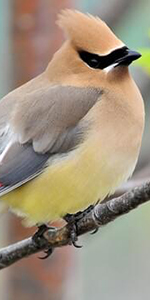| Cedar Waxwing | ||
 |
Classification(s) : | Prey |
| Cat Name : | Cardinal | |
| Common Name : | Cedar Waxwing | |
| Scientific Name : | Bombycilla cedrorum | |
| Other Name(s) : | ||
| Physical Description : | The Cedar Waxwing has a large light brown head, a yellow belly, and a short yellow-tipped gray tail. On its head is a crest which is usually flat, and its wide and pointed brown-gray wings are tipped with red. A black mask, bordered by white, covers the Cedar Waxwing’s eyes and throat. |
|
| Physical Statistics : | Length: 5.5 – 6.7 Inches (14 – 17 Centimeters) |
|
| Behavior : | The Cedar Waxwing is available throughout the year. It eats berries from trees year-round, and in the summer it also flies over water searching for insects. It typically nests in the fork of a branch that can be very high up from the ground. |
|
| Social Organization : | Flock; Cedar Waxwings are very social and almost always fly in groups. |
|
| Approval Level : | None; The Cedar Waxwing is fairly common in woodland. | |
| Kill Difficulty : | Low; The Cedar Waxwing is not very large and, when separated from the flock, short of defenses against cats. |
|
| Training Level : | Specialty - Group Flying; Most of the flock would need to be distracted in order to isolate a few weaker birds. |
|
| Hunting Tactic : | Birds | |
| Food Quality : | Medium; The Cedar Waxwing is on the small side, but has nutritious flesh due to its rich diet. | |
